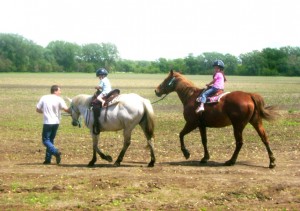 We took our kids riding yesterday afternoon. It was a glorious sunny day with typical 30 mph winds accompanying the warmth. We had recently purchased a new riding helmet for our daughter, since she had outgrown the smaller one, and felt like the best thing to do with our Sunday afternoon was to test it out. (Well, maybe more appropriately stated, we wanted to try it on for size….”testing it out” might imply we were hoping she would fall on her head and see how well the helmet protected her.)
We took our kids riding yesterday afternoon. It was a glorious sunny day with typical 30 mph winds accompanying the warmth. We had recently purchased a new riding helmet for our daughter, since she had outgrown the smaller one, and felt like the best thing to do with our Sunday afternoon was to test it out. (Well, maybe more appropriately stated, we wanted to try it on for size….”testing it out” might imply we were hoping she would fall on her head and see how well the helmet protected her.)
The kids were enthusiastic about riding. They love the horses, and often help care for them, throwing hay over the fence to them and brushing them whenever they get the chance. But we hadn’t been riding in awhile, and our youngest is a little uneasy about being on a horse by himself. He prefers to ride with me, but I’m usually riding horses that aren’t kid-safe. So Cowboy Dad threw them up into the saddles on Daisy and Cricket, and led them around for awhile. They aren’t able to handle the reins just yet, but being in the saddle was good practice for them.
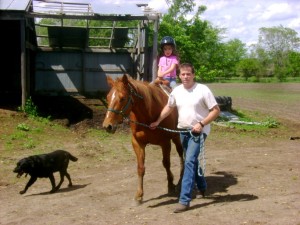
I was full of advice. “Don’t shriek,” I told my daughter, as I was adjusting her stirrups and she felt off-balance for a second and started yelling, “Horses don’t like loud sounds, and if you scream at something your horse does, it will probably make her scared and she might run. So never yell or scream around horses.” To my son, things were more simple. He was instructed to hang on to the saddle horn tight. That pretty much covered all he needed to know.
My daughter was helping me brush the horses when saddling, and I told her to always speak to a horse before walking behind it. She practiced saying, “Whoa, Cricket girl” every time she passed behind the horse. Cricket is tame enough to let you crawl under her belly, but some of our other horses are more flighty, so I wanted to set the principle to always speak and let the horse know of your presence.
After the kids rode, we all went on a ride down to the river. Cowboy Dad’s brother brought his little girl, and they rode together on Cricket. Dad led our daughter on Daisy, and I held our son and rode Toby. We just walked most of the way, with a few trotting sessions to catch up with the faster walking horses. Trotting is such a big deal to a little kid, it doesn’t take long before they are begging you to slow down again. Our dog Bullet went along for adventure, and it was a fun ride.
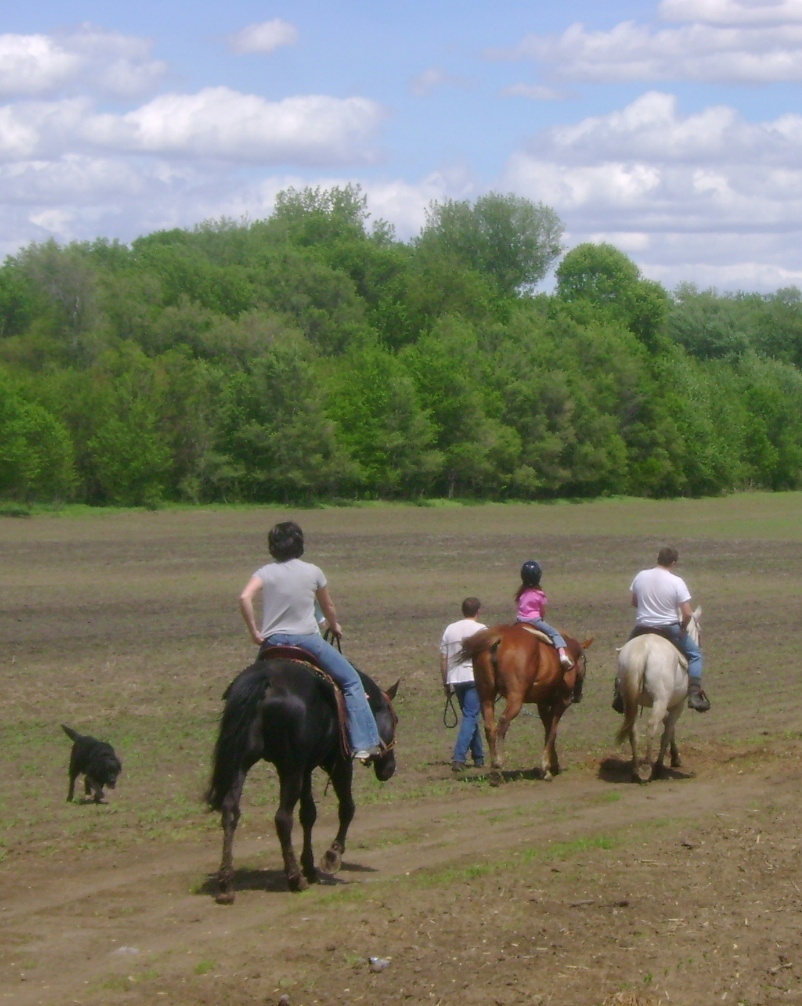
It got me thinking that this is the best way to get our kids used to horses. We didn’t do anything too strenuous, there was no work to do or real objective to our ride, but it helped the kids get used to being horseback, and it gave them a sense of accomplishment. The more they ride, the better balance they will have, they’ll be able to feel and predict the horse’s movements, and they will grow more comfortable with riding. It’s the best way to learn.
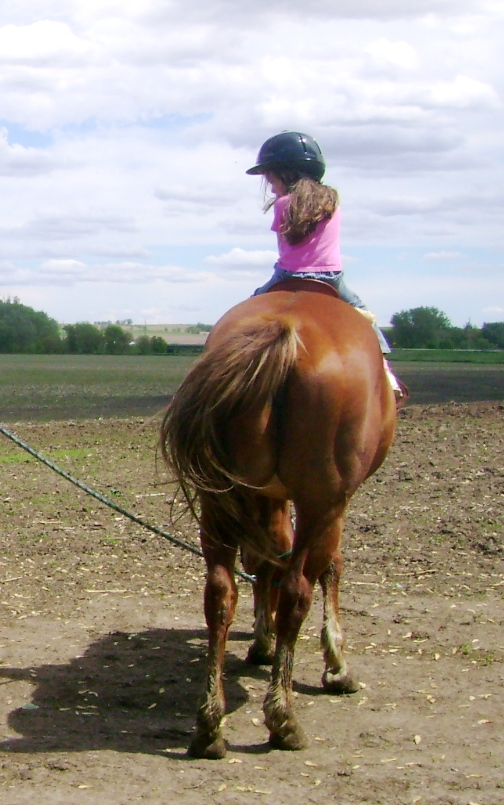 For those who don’t grow up around horses, it’s still possible to get a horse education, but it is often hampered by inhibitions and beginners mistakes. For those of us who had the opportunity to grow up around horses, responsibilities and safe horse-handling practices became lifelong habits. But there are a lot of families with children who are starting from scratch, buying their first horse, and have no idea how to go about handling one. Here are some basic guidelines that kids and beginners should know about horses:
For those who don’t grow up around horses, it’s still possible to get a horse education, but it is often hampered by inhibitions and beginners mistakes. For those of us who had the opportunity to grow up around horses, responsibilities and safe horse-handling practices became lifelong habits. But there are a lot of families with children who are starting from scratch, buying their first horse, and have no idea how to go about handling one. Here are some basic guidelines that kids and beginners should know about horses:
1. Horses cannot see directly behind them or right in front of their nose. Approach a horse from the side and pet his shoulder first, and always speak and lay your hand on his hip if you must walk behind him. The horse should know where you are at all times, so if you move, speak in a quiet voice to let him know where you’re at. Even the most gentle and best trained horse will still kick or run if startled, so never surprise a horse.
2. When leading a horse, always stand on its left side and keep your right hand on the lead rope under the horse’s chin to control it. The horse could step on you if it is allowed to move freely. The end of the lead rope should be folded accordion-style and held in your left hand. Never loop a rope around your arm, wrist, or hand.
3. Know how to tie a horse safely. Make sure that the horse is tied high enough that he cannot get a leg over the rope if he lowers his head. About two feet of rope between the knot and the horse’s halter is correct; anything longer can be really dangerous. Never walk under or step over the rope of a tied horse. Don’t tie a horse with a long rope to allow him to graze. Ropes can easily injure a horse’s legs, and bad accidents have happened because of tying a horse the wrong way.
4. Never attempt to help a horse that is panicked. If a horse is in trouble and thrashing about, wait until he calms down and stands still before you try to help him. Again, even the most gentle horse can cause deadly injuries because of his sheer weight and power…so wait until it is safe to untie or untangle a horse that’s in trouble.
5. In the movies, the cowboy always swings down from a horse by leaving his left foot in the stirrup and swooping his right leg over the horse’s back and to the ground. This looks fancy, but what if the horse spooks when the rider is standing with one foot on the ground and one foot still in the stirrup? It’s always safer to remove both feet from the stirrups, lean forward in the saddle to rest on your stomach or your hands on the front of the saddle, and swing your right leg over and drop both feet to the ground.
6. Wear appropriate clothing, footwear, and headgear around horses. If you wear shorts and sandals, be prepared for scratches, bruises, and saddle sores! Boots with a heel are best for riding, to keep your foot from slipping through the stirrup; if you fall and your foot is caught, you could be kicked in the head or drug underneath your horse. Helmets are always a good idea, because head injuries are so serious and you never know what may happen. Be prepared for the unexpected.
These are just a few of the things beginner riders should be taught first. The rest will come with practice and experience. Some people carry a lifelong fear of horses because of one small mistake that ended up in a big blowup, runaway, or fall. It’s far better to prevent an accident than to try to get over a fear of horses. So take it slow with beginner riders, don’t pushtoo hard or expect too much, but just let them be around horses as much as possible. It’s the best way to learn.
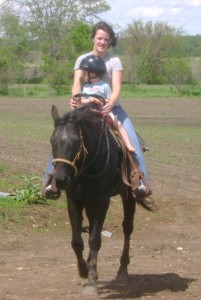
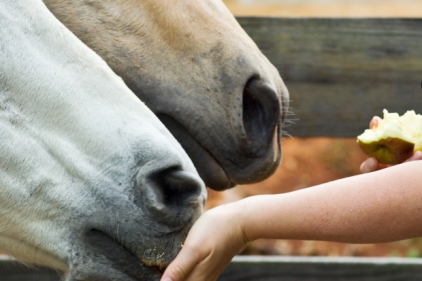

{ 1 comment }
Another great post! Horse safety is a must. I wish with all my heart that I was raised around horses and not just beginning! Life would be easier!
{ 1 trackback }